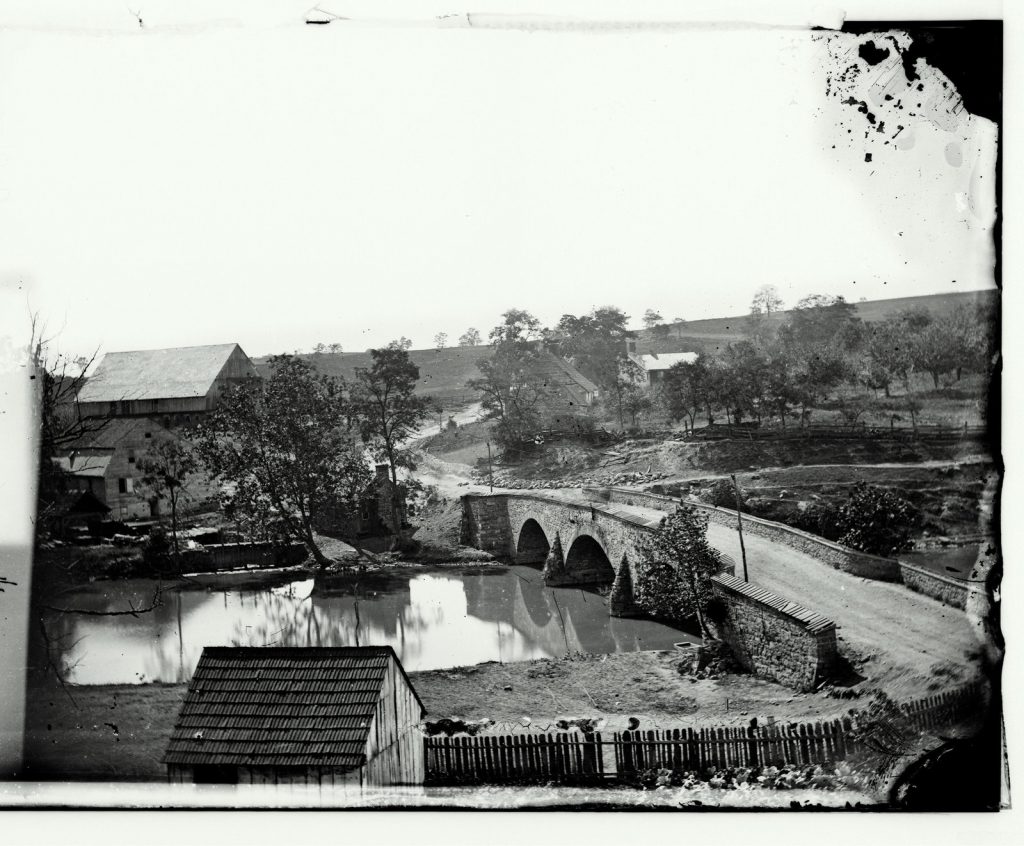The Collapse of a Battlefield Landmark: Antietam’s Middle Bridge
Whether they are well-studied or just passersby, both sets of visitors alike typically want to ensure they see one thing during their visit to Antietam National Battlefield: the Burnside bridge. And why not? The stories there are compelling, it is a quiet, scenic place, and everyone has seen the pictures that Alexander Gardner and James Gibson snapped on their post-battle visit to Sharpsburg and seared the bridge into the American psyche.

Altogether, the photographers captured 15 images in the immediate vicinity of the Burnside bridge. After memorializing that bridge, Gardner and Gibson traveled upstream to a larger and more heavily trafficked bridge the next day, where they likewise managed to photograph 15 pictures. This span, known as the Middle Bridge, carried the main east-west road across Antietam Creek into Sharpsburg. This crossing point is more heavily traversed today by commuters and local drivers than the Burnside bridge area. However, few probably realize where they are. The fighting at the Burnside bridge heavily overshadows the actions that occurred at the Middle Bridge on September 17. And, of the three primary bridges on the Antietam battlefield that figured prominently into the battle, the Middle Bridge is the only one that no longer stands.
The Upper, Middle, and Lower (Burnside) bridges all mirrored each other in design and size. Since the Middle Bridge sat along a more heavily traveled thoroughfare, it was slightly larger than its nearby relatives, being equipped with wider mouths to funnel the more consistent traffic onto the span. Much of the Army of Northern Virginia crossed it before taking their positions outside of Sharpsburg.
On September 17, 1862, the Middle Bridge was 48 years old. Three arches looped between the piers to support the roadway and traffic. From end to end, the bridge was 128 feet long. Throughout the day, Union artillery, cavalry, and infantry crossed it under fire of enemy artillery. Even portions of the Union infantry pushed close to the crest atop which the Confederate lines stood. Unfortunately, the story of this area of the battlefield has been largely overlooked. Perhaps some of that is because the Middle Bridge no longer stands.
Over two decades after the Battle of Antietam, the Middle Bridge showed “evidences of decrepitude,” according to the local Hagerstown newspaper. Repairs and patch jobs kept the bridge on life support. Unfortunately, these measures did not keep it alive forever. On June 19, 1891, at approximately 6:30 pm, the three arches collapsed, one by one like a row of dominoes. “The accident was caused by the gradual undermining of the piers causing them to sink slowly, thus weakening the arches,” said one assessment. Incredibly, no one was on the bridge when it fell.
Several iterations of a bridge went up in the old stone bridge’s stead but none of them were the Middle Bridge. Today, a modern highway bridge carries traffic across Antietam Creek, virtually wiping any trace of the 1814 structure from the battlefield landscape. Though the bridge is long gone, it lives on through Gardner’s photographs as an important landmark of the Battle of Antietam.
Great article, Kevin. I’ve often wondered about its demise.
Thanks, Brad. It was something I’d often wondered about and happened to stumble on this story while researching something else.
Any ideas as to why a small town such as Sharpsburg, would devote so many resources to bridges?
I enjoyed and learned from this post! Thanks.
Thanks for reading!
The article will cause me do some more reading about the bridges role during the campaign.
The Gardener photo was very helpful. Thanks for posting.
I’m glad it has piqued your interest. Thanks for checking it out.
Wow, great article, Kevin.